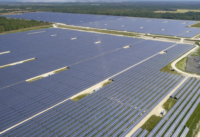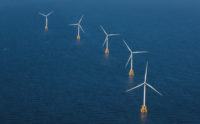ENR Sourcebook Power
Data and Renewables Drive Power Changes

In India, this 1,300-MW supercritical coal plant was commissioned in 2015.
PHOTO COURTESY OF LARSEN & TOUBRO
The growth of renewable generation is helping to feed the ever-increasing global demand for power using the renewable sources that are expected to comprise two-thirds of new generation by 2040, according to one scenario in the International Energy Agency’s World Energy Outlook, released in November.
Solar, wind and other renewable sources have become the lowest-cost alternative for most countries, supplanting coal plants. Coal has added 900 GW of new electric capacity since 2000, but coal is expected to supply only 400 GW through 2040, as even India and China turn toward renewable sources.
In Europe, renewables will account for 80% of new power generation by 2030, according to the International Energy Agency.
“Different players are entering the market and are prepping themselves for the future. The new-energy rush has set off,” says Daniel Develay, CEO of Tractebel. “Just look at gas-and-oil companies Shell and Total, which have acquired new firms to differentiate their service and product portfolio.”
Companies not traditionally associated with energy are investing in that market. For example, Google is filing patents for a floating solar farm.
Further, digital technology and data will transform the energy market, Develay says. Tractebel’s center for power system simulation and modeling, called EYES, is working to take advantage of that data to boost the energy transition. “We see that data are the new gold. Companies [that] have first access to a vast amount of data will be able to create [big] value out of it.”
Helping to make renewables more accessible and affordable is the growing development of cheaper battery storage that levels the intermittency of renewable generation. The global energy-storage market will rise dramatically, from 5 gigawatt-hours in 2016 to more than 300 gigawatt-hours and 125 gigawatts of capacity by 2030, according to a recent forecast by Bloomberg New Energy Finance.
One high-profile battery-storage project is a Tesla Powerpack lithium-ion system completed last month in South Australia. Following a series of blackouts last year, Tesla CEO Elon Musk offered to install his system in 100 days or it would be free. Partnered with Neoen, a French renewable-energy company, Tesla by Dec. 1 met the challenge, installing a $50-million, 100-MW, 129-MWh system at Neoen’s 315-MW Hornsdale Wind Farm. It is currently the largest battery-storage system in the world.
China also is pushing energy storage, with two giant projects in the early development stages. Dalian Rongke Power Co. Ltd. is building a 200-MW, 800-MWh storage station, featuring its vanadium flow batteries, on the Dalian peninsula. The first 100 MW will be installed by the end of this year, with the remainder coming on line in 2018. It will provide peak-shaving and enhance grid stabilization in Liaoning Province.
Hubei Pingfan Vanadium Energy Storage Technology Co. recently was awarded a contract to supply a 3-MW, 12-MWh vanadium battery-storage project in Hubei Province. It is the first phase of a 100-MW project, which will be the cornerstone a new, smart energy grid.
Coal will still play a role, however, as world energy demand is expected to grow by 30% by 2040—the equivalent of adding another China and India to the demand for electricity.
New coal plants are being built to burn fuel cleaner. “Reduction in [nitrogen oxide] and [sulfur oxide] emissions will be the key trend in the coal-based power market,” says Shailendra Roy, a director for power, heavy engineering and nuclear at Larsen & Toubro, India’s dominant contractor. “Accordingly, flue-gas desulfurization and selective catalytic reduction systems will play a major role.”
Also, the type of coal-fired generation is undergoing a shift. “The focus will be on supercritical and ultrasupercritical technologies to bring in higher efficiency, reduce usage of water and fuel, and reduce environmental emissions,” comments Roy. “Old plants will have to be replaced with ultrasupercritical or supercritical units, complete with FGD-SCR systems.”




